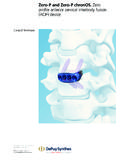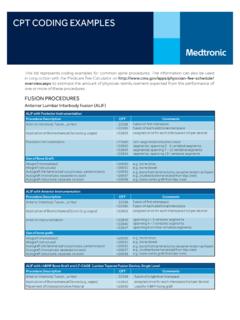Transcription of Direct Lateral Interbody Fusion – A Minimally Invasive ...
1 APPROVED Direct Lateral Interbody Fusion A Minimally Invasive Approach to Spinal Stabilization Because it involves accessing the spine through the patient s side, the Direct Lateral approach to Interbody Fusion offers surgeons and their patients a less Invasive option for spine surgery. Unless you ve studied anatomy, chances are you ve never heard of the psoas (soh-uhs) muscle. One of the unsung heroes of the body, this important muscle extends along the length of the lower spine and is responsible for stability, flexion and range of motion in the lower back and hips.
2 Precisely because of its location, it s also an integral part of a Minimally Invasive spinal Fusion procedure that s been gaining favor in the orthopedic community in recent years. Called Direct Lateral Interbody Fusion (DLIF), this approach to spinal Fusion allows access to the area to be treated while potentially minimizing disruption of the surrounding soft tissues and anatomical structures. The Interbody Fusion Approach to Spinal Stabilization Consisting of the five vertebrae (L1-L5) of the lower back, the lumbar spine bears the greatest amount of the body s weight, making it a common source of back pain.
3 Degenerative conditions, deformity and injury can lead to spinal instability which, if it results in pressure on the spinal cord and/or surrounding nerves, may ultimately cause back pain and other symptoms such as leg pain or muscle weakness that extends into the hips, buttocks and legs. If these symptoms persist for an extended period of time and have failed to respond to conservative treatment measures such as rest, medication, exercise and physical therapy, your surgeon may recommend a surgical procedure called spinal Fusion .
4 Spinal Fusion is sometimes recommended to treat conditions of the lower back, including Degenerative Disc Disease. The goal of spinal Fusion is to restore spinal stability, and the procedure typically involves removing the disc material from in between two adjacent vertebrae and then placing an implant and bone graft material into the disc space ( Interbody ) to promote bone growth that permanently joins together the two vertebrae ( Fusion ). Rods and screws are then placed posteriorly to create an internal cast that supports the vertebral structure during the healing process.
5 Click here to learn more about the Minimally Invasive screw placement system, CD HORIZON SEXTANT II. Gaining clear access to the spine, for both visualization and treatment of the affected vertebrae, is one of the most critical aspects of spinal Fusion surgery, and there are several different approaches a surgeon typically takes for an Interbody -type procedure. They include approaching the spine from the front of the body through an incision in the patient s abdomen (anterior lumbar Interbody Fusion [ALIF]), and approaching the spine through an incision in the patient s back over the vertebrae to be treated (posterior lumbar Interbody Fusion [PLIF] or transforaminal lumbar Interbody Fusion [TLIF].)
6 Factors that influence a surgeon s decision on which approach to take include the spinal condition to be treated, its location in the spinal column, his or her own training and surgical experience, available technology and the patient s overall general health. The DLIF Difference The DLIF procedure is different from other Interbody Fusion techniques in that to approach the spine, the surgeon makes a small incision in the skin of the patient s side. Then, using Minimally Invasive surgical techniques, he or she creates a narrow passageway through the underlying soft tissues and the psoas muscle - gently separating the fibers of the psoas muscle rather than cutting through it directly to the vertebra(e) and disc to be treated.
7 This is called the trans-psoas, or Direct Lateral , approach to Interbody spinal Fusion . The DLIF technique involves dilating through the soft tissues of the side rather than approaching the spine through the abdominal cavity or through a longer incision in the back, and may cause less disruption of the muscles and soft tissues than these traditional open techniques. DLIF is one of several Minimally Invasive spine procedures available today. Other procedures, such as Minimally Invasive decompression or Minimally Invasive TLIF, may be recommended depending on your condition.
8 The potential benefits of Minimally Invasive may include: Shorter hospital stays1 Smaller incisions and scars Decreased intraoperative blood loss2 Decreased post-operative medication needed while in the hospital1 However, even though DLIF is a Minimally Invasive procedure, it s important to remember that it is still spine surgery, and therefore not without risk. Potential risks associated with surgery include anesthesia complications, blood clots, allergic reactions and adverse effects due to undiagnosed medical problems, such as silent heart disease.
9 One Surgeon s View In recent years, the Direct Lateral approach to Interbody Fusion has gained favor with some spine surgeons. One is orthopedic surgeon Dr. Richard Hynes, staff physician with the Wuesthoff Medical Center in Melbourne, FL. Here, Dr. Hynes, the investigational team lead for a clinical trial on DLIF conducted at the Wuesthoff Center, shares his insights on the procedure. What have you found to be the benefits of the DLIF procedure? The DLIF approach is an alternative to other Interbody Fusion procedures, and I believe that for the right patient it can be an invaluable surgery.
10 Its benefits stem from the fact that you re approaching the disc from the side rather than from the front or back, and that you re able to do this through a very small, 1-2cm incision in the patient s side. What s there is mostly a little bit of muscle and fat, right behind the walls that hold the abdominal contents, it leads directly to the large psoas muscles that are attached to either side of the lumbar spine and overlay the discs. These muscles are large, and their fibers are easy to weave through to get to the side of the disc you re going to treat.







